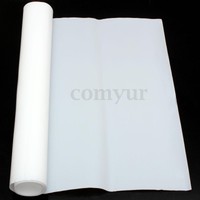Info
Rezensionen (5)

24. Nov 2016
Plastic film with many uses for tinkerers
Most of this is probably common knowledge for those who have worked with teflon/PTFE before (i.e. not me), but:
* Very good at becoming charged with static electricity (i.e. picks a lot of dust quickly).
* While flexible due to its thinness, it does retain some forms/bends/curves (its soft plastic, not cloth).
* Nicely translucent.
And this particular product:
* Both sides are quite smooth and somewhat slippery, but not "mirror-smooth". Should be very easy to clean.
I had planned to use it as a work surface for certain messy projects (as teflon is supposed to be easy to clean and does not react chemically with just about anything), but the static charge -property spoiled that plan. But I have other uses for it, too, going with its other useful properties.

08. Apr 2018
Worth the price
While it is certainly not perfect, it did the task well, where the two other tools I have failed (one with ratchet, one without, either the slots were a bit too small or big, or too wide die).
The bad sides: no ratchet, different dies could have slightly different widths for the same sized slots (some sizes are repeated in different dies), and the cutter is not really needed and is just a safety hazard, and it doesn't do the crimping of most connectors in one squeeze (some may even need switching of dies between wire and insulation crimps). I would not use this to do 1000 identical connectors in a row.
The good sides, which makes this better than the other ones I have, are that the dies are slim (can easily crimp even smaller barrels), there are so many different size slots that one of them will fit well, and the single tool (with possible die change) can handle many different connectors (instead of having to buy multiple tools before finding one that actually fits the task at hand). The bad side of having to do two squeezes per connector is also a benefit, since it gives flexibility over different type of connector, and e.g. putting oversized wire and crimping the insulator with even larger slot, works just fine with this tool.
The squeeze action takes a little to get used to, as the lack of ratchet/leverage makes the feel of forces much direct, and feels sort of "snap" a bit during the action. It first felt like having made too tight squeeze and thus a bad crimp, but it was actually just the moment when the sides finally yield from straight to curve shape. This could depend on the shape and size of the 'wings' being squeezed, too.
Very good for hobbyist.

15. Dez 2016
Nicer than expected
I can not check the material's (chemical) quality, but for the rest:
Its outer surface is slippery smooth. The inner surface is like very fine grain or "matte" i.e. not completely smooth but no visible marks, scratches or other features either. It is still smooth enough to clean up easily without leaving stains. (As tested very "scientifically" with strawberry jam and washing the remainders away with just warm water.)
The bottom is thicker than the wall; my specimen has about 3mm and 1.5mm respectively. The bottom edge is rounded inside, making the edge much thicker. All in all, it makes the cup quite bottom heavy, bottom area more rigid, and easier to clean; all good things. However, the wall area just above the bottom edge curve seems to get slightly thinner than elsewhere. Probably not an issue unless trying to get some frozen stuff to slide out of the bottom.
The side wall is a bit flexible, and it should survive quite hard drops; I won't test that, but at least it doesn't break when opposite sides of the top are squeezed or stretched about 5mm in or out.
Inside is about 52mm deep (at center) and about 42mm in diameter.
